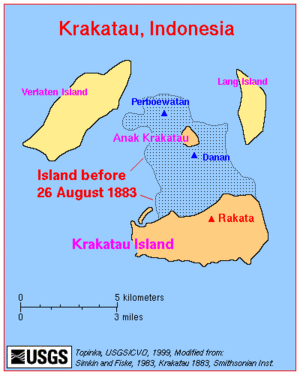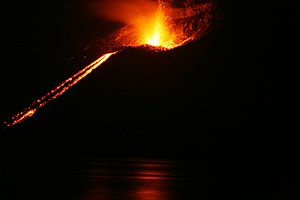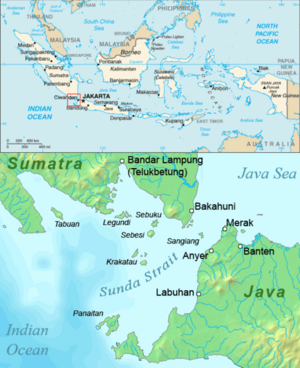Krakatoa facts for kids
Quick facts for kids Krakatoa |
|
|---|---|
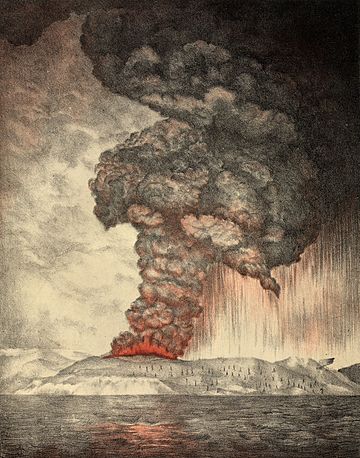
An 1888 lithograph of the 1883 eruption of Krakatoa.
|
|
| Highest point | |
| Prominence | 813 m (2,667 ft) |
| Geography | |
| Location | Indonesia |
| Geology | |
| Mountain type | Caldera |
| Last eruption | 2020 |
Krakatoa, or Krakatau, is a caldera in the Sunda Strait between the islands of Java and Sumatra in the Indonesian province of Lampung. The caldera is part of a volcanic island group (Krakatoa Archipelago) comprising four islands: two of which, Lang and Verlaten, are remnants of a previous volcanic edifice destroyed in eruptions long before the famous 1883 eruption; another, Rakata, is the remnant of a much larger island destroyed in the 1883 eruption.
Mount Krakatoa is an example of a stratovolcano.
In 1927, a fourth island, Anak Krakatau, or "Child of Krakatoa", emerged from the caldera formed in 1883.
There has been new eruptive activity since the late 20th century. On 22 December 2018 the central cone collapsed and caused a tsunami in the Sunda Strait. More than 400 people were killed.
Contents
Origin and spelling of the name
The earliest mention of the island in the Western world was on a map by Lucas Janszoon Waghenaer, who labelled the island "Pulo Carcata." ("Pulo" is a form of pulau, the Indonesian word for "island".) There are two spellings, Krakatoa and Krakatau, that are both acceptable. While "Krakatoa" is more common, Krakatau tends to be favored by Indonesians. The origin of the spelling Krakatoa is unclear, but may have been the result of a typographical error made in a British source reporting on the massive eruption of 1883. The colonial Dutch, however, used the spelling Krakatowa, probably to make the Dutch pronunciation more accurate.
Theories as to the origin of the Indonesian name Krakatau include:
- Onomatopoeia, imitating the noise made by white parrots that used to inhabit the island.
- From Sanskrit karka or karkata or karkataka, meaning "lobster" or "crab".
- From Malayan kelakatu, meaning "white-winged ant".
There exists a popular belief that Krakatau was the result of a linguistic error. According to legend, "Krakatau" was adopted when a visiting ship's captain asked a local inhabitant the island's name, and the latter replied "Kaga tau" - a Jakartan/Betawinese slang phrase meaning "I don't know". This story is largely discounted; it closely resembles famous linguistic myths about the origin of the word kangaroo and the name of the Yucatán Peninsula.
The name is spelled "Karata" on a map drawn prior to 1708.
Geographical setting
Indonesia has over 130 active volcanoes, the most of any nation. They make up the axis of the Indonesian island arc system produced by northeastward subduction of the Indo-Australian Plate. A majority of these volcanoes lie along Indonesia's two largest islands, Java and Sumatra. These two islands are separated by the Sunda Strait located at a bend in the axis of the island arc. Krakatau is directly above the subduction zone of the Eurasian Plate and the Indo-Australian Plate where the plate boundaries make a sharp change of direction, possibly resulting in an unusually weak crust in the region.
Before 1883
Before the 1883 eruption, Krakatoa was made of three islands: Lang and Verlaten (which were edge remnants left from an ancient, very large eruption) and Krakatoa itself. There were three volcanoes on Krakatoa island: Rakata, (820 m or 2,690 ft) to the south; Danan, (450 m or 1,480 ft) near the center; and Perboewatan, (120 m or 390 ft) to the north.
The 1883 eruption
The 1883 eruption ejected more than six cubic miles (25 cubic kilometers) of rock, ash, and pumice, and made the loudest sound ever recorded by human beings. The sound was heard as far away as Perth in Australia (3,500 km; 2,200 miles), and the island of Rodrigues near Mauritius (4,800 km; 3,000 miles). Many thousands of people were killed and injured by the eruption, mostly in the tsunami (giant wave) which followed the explosion.
The pressure wave from the final explosion was recorded on barographs around the world, which continued to register it up to 5 days after the explosion. The recordings show that the shock wave from the final explosion reverberated around the globe seven times.
The eruption destroyed two-thirds of what was then the island of Krakatoa. New eruptions at the volcano since 1927 have built a new island, called Anak Krakatau (child of Krakatoa).
Aftermath
Anak Krakatau
Verbeek, in his report on the eruption, predicted that any new activity would manifest itself in the region which had been between Perboewatan and Danan. This prediction came true on 29 December 1927, when a submarine lava dome in the area of Perboewatan showed evidence of eruptions (an earlier event in the same area had been reported in June 1927). A new island volcano rose above the waterline a few days later. The eruptions were initially of pumice and ash, and that island and the two islands that followed were quickly eroded away by the sea. Eventually, a fourth island, named Anak Krakatau (meaning "child of Krakatoa" in Indonesian), broke water in August 1930 and produced lava flows more quickly than the waves could erode them.
Political
The explosion was the first natural disaster in history whose effects were definitively felt worldwide and whose cause was known, following the development of transoceanic communication cables. Winchester suggests the disaster marks the birth of an era of global awareness.
Biological research
The islands have become a major case study of island biogeography and founder populations in an ecosystem being built from the ground up in an environment virtually cleaned.
The islands had been little studied or biologically surveyed before the 1883 catastrophe—only two pre-1883 biological collections are known: one of plant specimens and the other part of a shell collection. From descriptions and drawings made by HMS Discovery, the flora appears to have been representative of a typical Javan tropical climax forest. The pre-1883 fauna is virtually unknown but was probably typical of the smaller islands in the area.
Botanical studies
From a biological perspective, the Krakatau problem refers to the question of whether the islands were completely sterilized by the 1883 eruption or whether some indigenous life survived. When the first researchers reached the islands in May 1884, the only living thing they found was a spider in a crevice on the south side of Rakata. Life quickly recolonized the islands, however; Verbeek's visit in October 1884 found grass shoots already growing. The eastern side of the island has been extensively vegetated by trees and shrubs, presumably brought there as seeds washed up by ocean currents or carried in birds' droppings (or brought by natives and scientific investigators). However, the floral ecosystem on Rakata is considerably vulnerable to environmental factors, and has been damaged by recent eruptions at Anak Krakatau.
Handl's occupancy
In 1914, plans were to set aside Rakata as a nature preserve. In 1916, Johann Handl, a German "pumice collector", obtained a permit to mine pumice, against "strong community objections", apparently to get away from World War I. His lease of 8.7 square kilometres (3.4 sq mi) (basically the eastern half of the island) was to be for 30 years. Handl took up residence on the south coast of Rakata, where he built a house and planted a garden along with "four European families and about 30 coolies". Handl found un-burned wood below the 1883 ash deposits while digging, and fresh water was found below 5.5 metres (18 ft). He and his entourage stayed there for four years, but left due to "violation of the terms of the lease." It is his party that is believed to have inadvertently introduced the black rat to the island, which quickly proliferated.
Conservation
Krakatoa was declared as a nature reserve in 1921, corresponding to IUCN management category Ia (strict nature reserve). Along with several other nature reserves, it was proposed as a national park in 1980. In 1991, "Ujung Kulon National Park and Krakatau Nature Reserve" was inscribed as an UNESCO World Heritage Site, matching Natural criteria (vii) and (x). Ujung Kulon National Park was officially established in 1992, including Krakatoa.
Popular culture
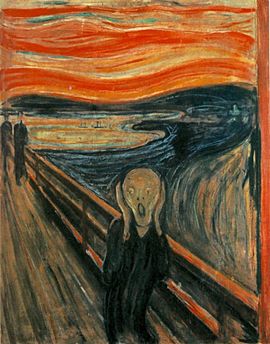
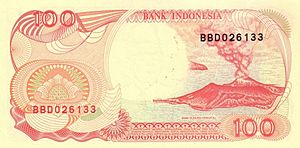
A large part of the 1947 children's novel The Twenty-One Balloons by William Pene du Bois takes place on Krakatoa, where several families have established a wealthy and fanciful colony based on fictional diamond mines on the island.
Krakatoa has been featured as a subject and a part of the story in various television and film dramas. In the 1953 film Fair Wind to Java, an American sea captain and a pirate leader race one another to recover a fortune in diamonds hidden on Krakatoa, which begins its final eruption as they search the island for the treasure. The island was a prominent part of the plot of '"Crack of Doom," episode six of the Irwin Allen television series The Time Tunnel in 1966. It was also featured as the main part of the story line in the 1969 film, Krakatoa, East of Java (retitled Volcano in a re-release in the 1970s; the title contains a rather large geographical error, as Krakatoa is west of Java), which depicts an effort to salvage a priceless cargo of pearls located perilously close to the erupting volcano. An Indonesian martial arts action film, Krakatau (1977), starring Dicky Zulkarnaen and Advent Bangun, also set the story on the mountain. In more recent years, it has been the subject of a 2006 television drama, Krakatoa: Volcano of Destruction and again in 2008 as Krakatoa.
In Klaus Teuber's board game Seafarers of Catan, the "Krakatoa Variant" is a scenario involving an island composed of three volcano tiles.
In 1973, the American progressive rock band Styx released a spoken-word track called "Krakatoa" on its album The Serpent Is Rising. Written by then-guitarist John Curulewski along with Paul Beaver and Bernie Krause, the song tells the story of Krakatoa's eruption and the subsequent return of life to the island.
Related pages
Images for kids
-
Simon Winchester maintains that the 1680 eruption was depicted in this eighteenth-century Dutch etching
See also
 In Spanish: Krakatoa para niños
In Spanish: Krakatoa para niños



